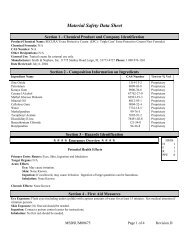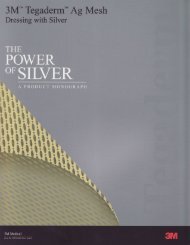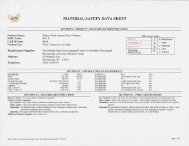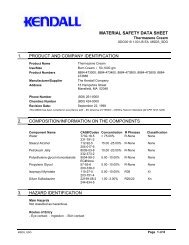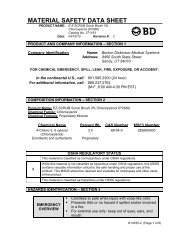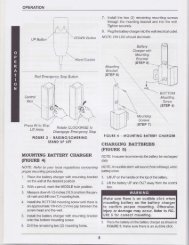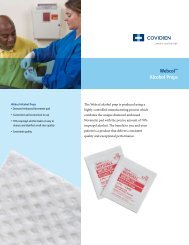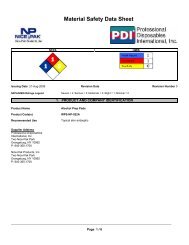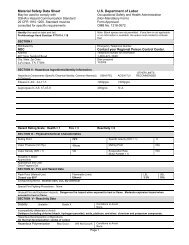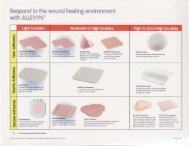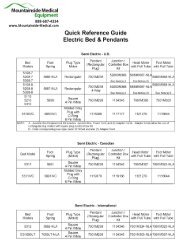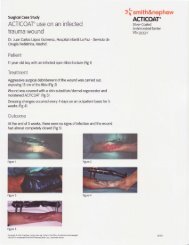Can SP02 reading change - Mountainside Medical Equipment
Can SP02 reading change - Mountainside Medical Equipment
Can SP02 reading change - Mountainside Medical Equipment
Create successful ePaper yourself
Turn your PDF publications into a flip-book with our unique Google optimized e-Paper software.
Smiths <strong>Medical</strong> PM, Inc.<br />
How can SpO 2 <strong>reading</strong>s differ from<br />
manufacturer to manufacturer<br />
Principle<br />
Pulse oximetry combines the principles of optical plethysmography and<br />
spectrophotometry to determine arterial oxygen saturation values. Optical<br />
plethysmography uses light absorbance technology to reproduce waveforms produced by<br />
pulsating blood. Spectrophotometry uses various wavelengths of light to perform<br />
quantitative measurements about light absorption through given substances.<br />
Technology<br />
Two wavelengths of light are passed through body tissue via light emitting diodes<br />
(LED) to a photodetector. The two LEDs are red light and infrared light. Theses two<br />
LEDs are chosen because light absorption varies with the oxygen concentration of<br />
hemoglobin in both the red (660nm) and infrared (890-940nm) light. The pulse<br />
amplitudes of the red and infrared signals are detected and measured to produce a Ratio<br />
value.<br />
0% Saturation 81% Saturation<br />
100% Saturation<br />
Red light<br />
absorption<br />
Infrared<br />
light<br />
absorption<br />
The red light amplitude (AC red) is divided by the infrared light pulse amplitude<br />
(AC ir) to form the intermediate value called Ratio.<br />
Ratio = AC RED / DC RED<br />
AC IR / DC IR
Ratio is used as the input to a “lookup table” function in the pulse oximeter. The SpO 2<br />
value is the result of the “lookup” function.<br />
SpO2 vs. Ratio<br />
SpO2 (%)<br />
100<br />
90<br />
80<br />
70<br />
60<br />
50<br />
40<br />
30<br />
20<br />
10<br />
0<br />
0.4<br />
0.6<br />
0.8<br />
1<br />
1.2<br />
1.4<br />
1.6<br />
1.8<br />
2<br />
2.2<br />
2.4<br />
2.6<br />
2.8<br />
3<br />
3.2<br />
3.4<br />
Ratio<br />
SpO 2 Computation<br />
Each manufacturer uses a unique calibration curve. A calibration curve is an<br />
algorithm that is empirically derived as a result of data obtained from desaturation<br />
studies. It relates light transmittance to oxygen saturation mathematically. Each pulse<br />
oximetry manufacturer develops it’s own proprietary calibration curve; no two are alike.<br />
Desaturation studies consist of recording data from many human test subjects at<br />
different levels of saturation or desaturation. Measured arterial blood saturations and<br />
SpO 2 <strong>reading</strong>s are obtained and recorded at each level of desaturation. Desaturation is<br />
induced by having the subjects breath a hypoxic gas mixture. This process is repeated<br />
over and over with many different test subjects. The data is then plotted on a graph. A<br />
proprietary calibration curve is developed by making the best fit of the SpO 2 data against<br />
the measured data within accuracy specifications.<br />
Accuracy Specifications<br />
The industry standard for pulse oximetry accuracy specifications is +/- 2 digits.<br />
This specification is usually equal to +/- 1 standard deviation of 68% of the test<br />
population; 1 standard deviation above and below the line of identity on a graph relating<br />
true to measured values. Therefore any two pulse oximeters, regardless of manufacturer,<br />
can display different SpO 2 <strong>reading</strong>s and still be accurate. Some manufacturer’s SpO 2<br />
<strong>reading</strong>s are higher than an actual measured SaO 2 , some are lower and some read the<br />
same, but they are all within +/- 2 digit specifications.
Below is an example of three different manufacturer’s SpO 2 <strong>reading</strong>s compared to the<br />
actual arterial blood saturation measured with a laboratory co-oximeter. All three<br />
manufacturer’s <strong>reading</strong>s are considered accurate because they are within said<br />
specifications. Remember, a higher <strong>reading</strong> does not necessarily equal a more accurate<br />
<strong>reading</strong>, as demonstrated with the 100% SpO 2 below. It is not possible to be 100%<br />
oxygen saturated due to the normal anatomical ventilation to perfusion mismatches of<br />
the human body, yet pulse oximeters read 100% and are considered accurate.<br />
Manufacturer 1 Manufacturer 2 Manufacturer 3 Co-Oximeter<br />
SpO 2 96% SpO 2 98% SpO 2 100% SaO 2 98%<br />
-2 % O +2 % Measured (actual)<br />
Summary<br />
Each pulse oximetry manufacturer uses various wavelength LEDs which will affect the<br />
Ratio obtained. The calibration curve is empirically derived from dynamic data that<br />
contains many variables. Manufacturers adjust their proprietary calibration curve in<br />
order to meet a specification range. Based on this information, it is understandable how<br />
an SpO 2 <strong>reading</strong> can vary from manufacturer to manufacturer and still be accurate.<br />
Sources<br />
Carlson, K. & Jahr, J. A historical overview and update on pulse oximetry.<br />
Anesthesiology Review. September/October. 1993; 20 (5).<br />
Chatburn, R., Kallstrom, T. & Volsko, T. Evaluation of a commercial standard for<br />
checking pulse oximeter performance. Respiratory Care. February, 1996; 41(2)<br />
Des Jardins, T. Cardiopulmonary anatomy and physiology, 3rd Edition. Delmar<br />
Publishers, Boston. 1998.<br />
Garland, J.K. Pulse oximetry. A respiratory therapy prospectus. The <strong>Can</strong>adian Journal<br />
of Respiratory Therapy. February 1990; 26 (1).<br />
Rusch, T., Scharf, J. & Sankar, R. Signal processing methods for pulse oximetry.<br />
Comput. Biol. Med. 1996; 26 (2).<br />
Severinghaus, J. Et al. History of blood gas analysis VI. Oximetry. Journal of Clinical<br />
Monitoring. 1986;2 (4).<br />
Smiths <strong>Medical</strong> PM, Inc.<br />
N7 W22025 Johnson Road<br />
Waukesha, WI 53186-1856 USA



